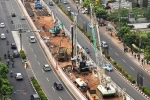This article has been translated by PwC Indonesia as part of our Indonesia Infrastructure News Service. PwC Indonesia has not checked the accuracy of, and accepts no responsibility for the content.
Bisnis Indonesia - Infrastruktur transportasi: Misi pelik tata logistik
20 May 2024
By Anitana W. Puspa and Stefanus Arief Setiaji
Over the past 10 years, the government has been steadily improving facilities and infrastructure, including roads, bridges, ports, and airports. These efforts to enhance connectivity aim to facilitate the distribution of goods and services and grow the economy.
On Monday (13/5), President Joko Widodo inaugurated regional roads in West Muna Regency in Southeast Sulawesi Province.
West Muna is an expansion of Muna Regency. The regency recently turned 10 years old as it was recently established in 2014.
Based on the data from Statistics Indonesia (BPS), the region has 517.58 kilometres of roads. Of these, approximately 41% are classified as damaged or severely damaged.
During the inauguration of regional roads in the regency, President Jokowi affirmed the government’s commitment to continuously develop and improve infrastructure. This aims to accelerate public and logistics mobility, enhancing the quality of life of the people.
According to the Head of State, excellent road infrastructure development is essential to ensure transportation efficiency and logistics distribution, which will significantly impact the local economy.
“We hope everything will go well, so the movement of passengers, goods, and other resources is smooth and efficient,” the Head of State stated.
Infrastructure, encompassing roads, ports, and airports, serves as the backbone of logistics activities. The speed and efficiency of the distribution of goods and services to various regions depend on the reliability of connectivity.
In the last 10 years, the government has aggressively pursued infrastructure development to ensure balanced connectivity, support economic activities, and attract investment.
Furthermore, over the last two decades, Indonesia has faced the persistent challenge of inadequate logistics performance.
According to the Logistics Performance Index (LPI) of the World Bank, infrastructure serves as a benchmark alongside customs and excise as well as workforce competence in the logistics sector.
Another benchmark indicator for the World Bank is international shipping routes, which are closely tied to port infrastructure. Additionally, there is also punctuality that is linked to the availability of roads, ports, shipping activities, and a cargo tracking system.
Out of the six indicators for the World Bank to measure the logistics performance of a country, three of them are related to infrastructure availability and appropriateness.
Based on the data of the World Bank in 2023, Indonesia’s LPI score was 3 out of 5. In Southeast Asia, Indonesia is still under Singapore, Malaysia, Thailand, and Vietnam.
Compared to the LPI score in 2018, Indonesia's infrastructure score remained relatively stable at 2.9. Meanwhile, the customs score improved from 2.67 in 2018 to 2.8 in 2013, while other indicators experienced declines.
It is quite normal to see a decline in other indicators, given that domestic and global logistics activities were hindered by the Covid-19 pandemic from 2020 to 2022.
National target
Indonesia’s LPI score of 3 in 2023 still fell below the target set by the government.
In the 2020-2024 National Medium-term Development Plan (RPJMN) prepared by the National Development Planning Ministry/National Development Planning Agency (Bappenas), the LPI score target for 2020 was at 3.2 with logistics costs predicted to reach 23.2% of the gross domestic product (GDP).
By the end of the administration of President Jokowi in 2024, the LPI score is set to reach 3.5 with logistics costs set to reach 18% of the GDP.
According to the data from Bappenas, national logistics costs in 2023 amounted to 14.29% of the GDP. This indicates a shortfall from the target outlined in the 2020-2024 RPJMN, which aimed to reach 18% of the GDP. However, the reduction of logistics costs relative to the GDP suggests an increasingly efficient logistics ecosystem.
Interestingly, when domestic logistics costs are considered efficient, the LPI score tends to remain stagnant.
At Bisnis Indonesia Shipping & Logistics Forum 2024 held by Bisnis Indonesia at the end of April 2024, Sea Transportation Director General of the Transportation Ministry Antoni Arif Priadi stated that Indonesia struggled to overcome high logistics costs primarily because of the dominance of land transportation.
“The most important factor is logistics costs, which are particularly relevant because we are an archipelago,” he stated.
To reduce logistics costs, he said that the Transportation Ministry was establishing clusters in the maritime sector to identify the role of stakeholders in the maritime industry. Through these clusters, ministries and institutions can carry out their roles to reduce logistics costs.
“We are preparing the clusters. Who is in the first layer, second layer, and so on. Each institution must be interconnected,” Arief said.
Besides that, he said that there was another problem in reducing logistics costs, which is old ships. The average age of ships in Indonesia exceeds 15 years old.
With this average age of ships, only 10 years of optimal operation remains. This will affect their competitiveness in the distribution of cargo and services in the maritime sector.
According to Indonesian National Shipowners’ Association (INSA) Chairperson, Carmelita Hartoto, sea cargo delivery was more efficient than land transportation because it can carry larger volumes.
She said that national shipping could serve all commodities throughout Indonesia. Shipping is also continuously developing along with technological advancements.
Carmelita appreciates the government’s logistics organisation. However, numerous issues must still be addressed, such as imbalanced regional economic growth, which makes the utilisation of ships, trucks, and other modes of transportation to be suboptimal.
Another issue is infrastructure from and to ports that still needs to be organised, including additional costs beyond official expenses that must be borne by business players.
“We are hoping for equal fiscal and monetary policies to improve the competitiveness of shipping,” she said on Friday (17/5).
Furthermore, shipping players are hopeful for comprehensive policies to tackle national logistics challenges and consistent policies regarding logistics.
In addition to that, there is a need for service enhancements from stakeholders in the form of faster systems utilising various technologies as well as improvements in human resources for port services.
Carmelita is proposing the establishment of an institution in the logistics sector tasked with managing the national logistics ecosystem comprehensively.
“We are an archipelago that requires multiple modes of transportation for logistics distribution. This is related to the efficiency of the national logistics costs.”
Next article: Logistics cost component - Long road to streamlining


















